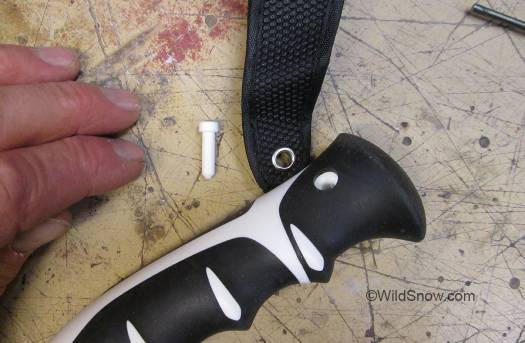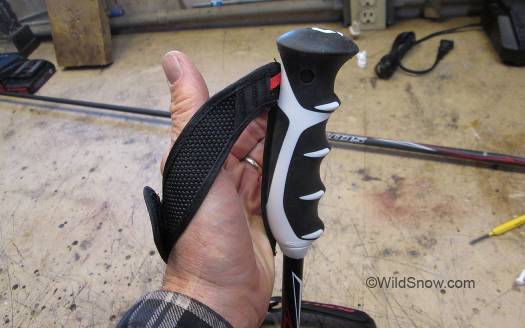Readers please note the Scott SRS pole strap safety system is not available as a retrofit, the only way to obtain it is to purchase a new pair of Scott poles or possibly a complete set of replacement ski pole grips.
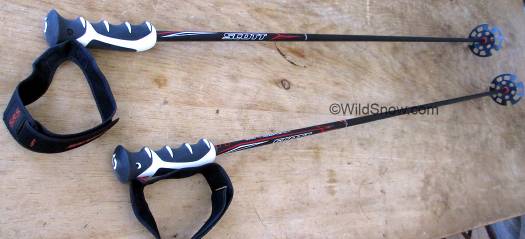
Scott Series C tapered composite poles, retrofitted with S.R.S safety strap system. These are sweet ski poles, alu tip cover worked the heel units on all the tech bindings I tried it on. Shaft is flexible, but not too much so. The grips normally have a cosmetic finishing ferrule on the bottom, we left that off, FYI if you don’t like the abrupt transition from grip to skinny pole. Click images to enlarge.
Shoulder surgery. Possibly a year of recovery. Physical therapy you could classify as illegal torture. Weeks after the knife you might even have trouble operating a computer keyboard — let alone feeding yourself. Skiing? Next season.
A ski pole safety release system that works can be a godsend. Sure, you probably don’t want release straps for ski alpinism that involves dragging your poles over rock scrambles, while freeing up your hands to grab a hold (whoops, what’s that sound, a clattering ski pole seeking flight?). Same with extreme bush whacking. But for normal ski touring, when a tree root or avalanche asks to keep your poles, safety release can save your shoulders and possibly even your life.
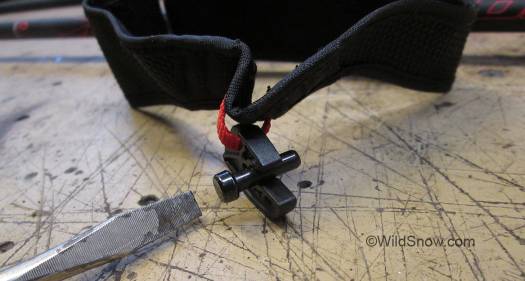
Scott S.R.S Strap Release System is simply a plastic clip that cams on to a horizontal pin in the pole grip. When inserted correctly, it is pretty much permanent when pulled at normal angles, but an upward pull pops the strap out of the grip. I’ve had quite a few other systems of this sort, many problem was the straps tended to fall out and get lost. S.R.S. appears to have a firm grip even at the release angle so it’s less likely to ‘pre release.’ Screwdriver is shown for scale, not required for the retrofit. Click all images to enlarge.
Enter the Scott S.R.S., an elegantly engineered solution that involves a simple plastic clip and steel pin in the pole grip. Both easily retrofitted to current Scott model ski poles (or available installed on certain models). I installed S.R.S. (SRS) on a pair of nice new Scott Series C carbon sticks. These are high-end ski poles, with replaceable tips and super strong filament-wound composite shafts. They’re not as flexy as my all-time favorite carbon poles, but still give a bit, thus absorbing impact abuse that can transfer into elbow and shoulder problems. The retrofit was easy and the release system seems to be working. Age old question with this: will the straps stay on when doing things such as carrying ski poles on backpack? Time will tell. I’ll amend this post once I’ve done longer term testing.
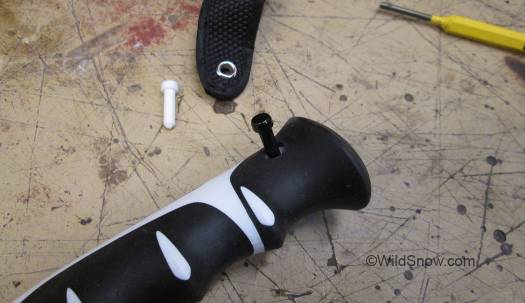
You then push the steel pin into the grip, I tapped it with a plastic mallet to make sure it was seated.
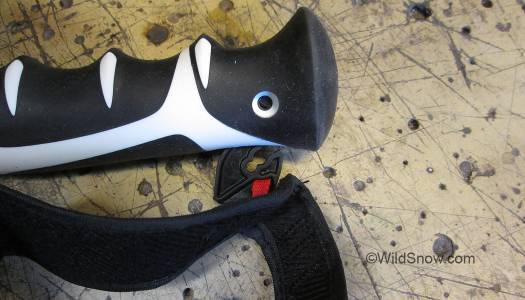
Release clip is inserted like this, I had to push on it with the other pole grip to get it all the way in (it seats with a satisfying snap).
(Shop hints from Lou: Removing ski pole grips, try dipping in boiling water for a few minutes then pulling off. Nearly always works for us unless the grips have some kind of mechanical fastener. If the grip seems to go back on too easily, lay a band of electrical tape over the top end of the pole shaft and hammer the grip on over that. Or try just roughing up the shaft with sandpaper and applying a bit of Gorilla Glue inside the grip. Easy to test grip retention when you’re done. Some baskets actually screw off with course threads, while others pop off (e.g., Scott). In either case, the boiling water trick still helps. Try pulling and rotating the basket first. If that doesn’t work, place feet (with stiffer shoes) on either side of basket and step down firmly. When replacing baskets, do it when they’re warm and lube with a bit of water. When cutting composite ski pole shafts, work your way around the complete circumference of the shaft with a hacksaw, then gradually saw through, this to prevent carbon fiber “runners” from royally messing things up.”)
WildSnow.com publisher emeritus and founder Lou (Louis Dawson) has a 50+ years career in climbing, backcountry skiing and ski mountaineering. He was the first person in history to ski down all 54 Colorado 14,000-foot peaks, has authored numerous books about about backcountry skiing, and has skied from the summit of Denali in Alaska, North America’s highest mountain.

